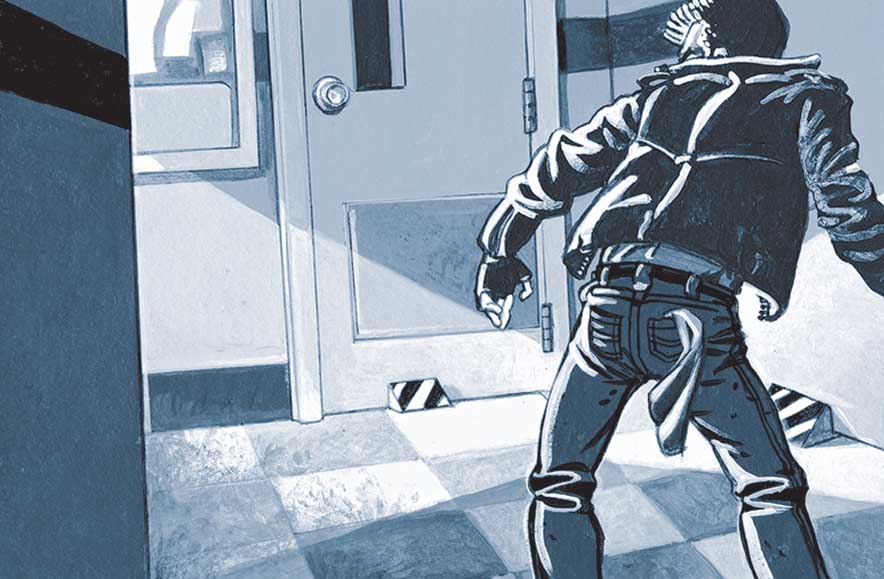Barring Imminent Threats
Mentor Public School District, 20 miles east of Cleveland, Ohio, is home to nearly 8,000 students from preschool through 12th grade. The school district keeps its safety and security plans at the forefront, conducting year-round safety drills, says Matthew Miller, district superintendent. “Whenever we talk to groups–whether it’s our own teachers or the Parent Teacher Association–the first thing that we focus on is safety,” says Miller. The school district also works closely with local fire and police departments to conduct joint safety drills, and the organizations communicate often. “We spend a lot of time together talking about different scenarios, we’re always in contact with one another when something comes up.”
In late 2013, the Mentor County fire chief was approached by National School Control Systems, a company that produces barricades to protect classrooms or any area with a traditional interior door–such as gymnasiums, offices, and cafeterias–in the event of a lockdown. Representatives told the chief about the BEARACADE product and possible deployment in the community. The fire chief then brought BEARACADE to Miller.
The BEARACADE is a lightweight door barrier, weighing about two pounds. Made of a high-impact modified polycarbonate it can withstand up to 4,600 pounds of pressure. The product can be installed by maintenance staff at the customer site by drilling holes in the floor.
Miller says that in an emergency, such as an active intruder or shooter situation, deploying the device is simple. Teachers and administrators simply take the BEARACADE off a spot on the wall where it hangs and slide it along the bottom-inside of the door. It prevents the door from being opened from the outside. “There’s no guesswork involved because there’s a pinhole that’s predrilled into the floor, and there’s a stopper to stop the device when you’re sliding it across the bottom of the door,” he notes.
Miller saw value in the product, which he felt was cost-effective and easy to deploy–he says the total cost of the project was approximately one dollar per student per classroom. Miller presented the idea to the president of the Parent Teacher Association (PTA). The group expressed strong support for the product. “Once they saw it and we talked about it, it was a go after that,” notes Miller.
In June 2014, the first devices were delivered to the district, which has 14 school buildings and two support facilities. The school district installed 500 devices across its 16 facilities. “Ideally at the end of the day we want them in all of our classrooms and offices, so we still have some more to order.”
Teachers and administrators have been trained in deployment of the barricades. The school conducts monthly safety drills, whether it be a lockdown, tornado, or fire drill. However, Miller says that the school focuses mainly on the lockdown drills, given the frequency of active shooter situations.
While students haven’t been trained on using BEARACADE, Miller says older students who have seen it in action during drills could likely perform the deployment in an emergency. In terms of possible misuse, he notes the BEARACADE is visible from the outside along the bottom of the door if it has been deployed so anyone in the hallway could see there was a potential problem. “So a teacher or an administrator can say, ‘hey that’s not right, that shouldn’t be deployed, and there’s nothing wrong in the building right now.’ They can go to the door, knock on it, call the office, or 911.”
The outside visibility of BEARACADE also means that law enforcement can perform a more effective sweep of the building in the event of a dangerous situation. “So if you’re looking for the bad guy, it’s probably going to be a room or an area that’s not barricaded off,” Miller says. The manufacturer divulges information only to first responders and teachers on how to break through the barricade using a trademarked process.
One challenge the district anticipated was deploying the BEARACADE at a facility with open-concept classrooms, where accordion partitions and bookshelves take the place of traditional walls. However, after working through drills, the administration came up with a solution. Students, teachers, and faculty all fit comfortably in the handful of rooms and closets that do have doors. Now, during drills, all building occupants practice going to one of these rooms.
“There are traditional rooms and large closets nearby that are BEARACADE-enabled,” says Miller of the building with nontraditional walls. “I don’t think that’s something we thought would have happened, but when we practiced our drills we were able to see pretty quickly that we could still use the barricade and all the kids could be behind a door.”
Mentor Public Schools has never had to use the BEARACADE in a real-life scenario, but schools continue to conduct safety drills in case that moment ever comes. “It’s a very cost-effective way to potentially save a lot of lives in a very bad situation. You can’t really put a price on that,” says Miller.
